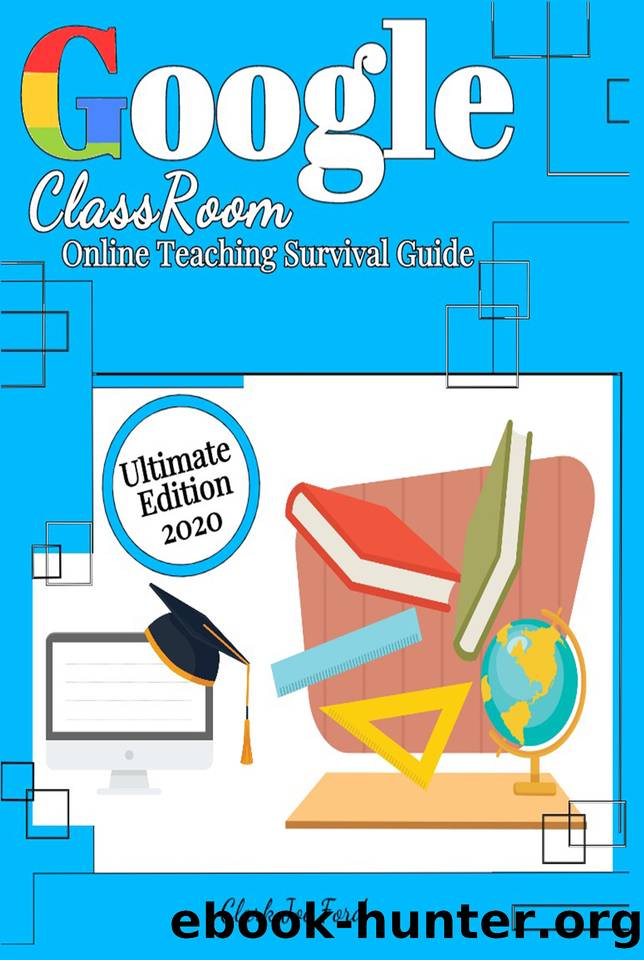GOOGLE CLASSROOM: Step-by-step Guide for Easy Google Classroom Use. Perfect for Teachers and Students. by CLARK JOE FORD

Author:CLARK JOE FORD [FORD, CLARK JOE]
Language: eng
Format: azw3, mobi
Published: 2020-08-16T00:00:00+00:00
Use this free sample or other resources to assign and implement various tasks via the Google Classroom. The more Google Classroom you use, the more you'll discover what you can do with this excellent software.
Google Classroom As Learning Management System (LMS) For Teaching English
So to meet the changing requirements of learners in the 21st century, a paradigm shift in teaching English methodology is required. One of these groundbreaking methodologies is the use of LMS systems, which offer a mixed learning environment. Google Classroom is a free LMS that contains Google Educational Features. The objectives are to report on the overall experience of Google Classroom at the level of undergraduate education in formal, face-to-face English. Through this, I will look at the reasons why Google Classroom is used by teachers and the effectiveness as well as the limitations of teachers.
System of Learning Management (LMS)
LMS is really the infrastructure that provides and manages educational content, identifies and evaluates organizational and individual learning or training objectives, tracks progress towards these objectives, and collects and displays data to supervise an organization's learning process.
An LMS enables a trainer to monitor students, distribute learning materials, create platforms that discuss ideas, assign and evaluate work, provide feedback, and grade students. Briefly, an LMS offers the instructor a room to track and encourage students ' learning progress. On the other hand, students can benefit because they can learn at their own pace. An LMS enables a teacher to build an online environment for determining a student can participate in a number of activities relating to learning. An LMS may become a repository of instructional material, a tool for administrative purposes, or may even become a virtual classroom, depending on how it is used. According to Pratt and Palloff (2002), "the online classroom is a potential powerful field of teaching and learning that can make significant contributions to learning through new practices and relationships."
A good LMS should support collaborative learning both within and outside physical schools, enable students to control their learning pace of goals and knowledge, allow student progress to be tracked and reported, and provide all interested parties with a platform which to interact and work together. Educational intuitions in today's world are aware of the potential of an LMS to enhance learning efficiency and collaboration, using popular commercial LMS tools such as Desire2Learnor, WebCT, Blackboard, and open-source platforms such as Moodle to provide a blended study approach.
Existing commercial LMS have limits of their own. In the first place, most are very expensive and can not be afforded by all educational institutions. From a teacher's point of view, if the institution leaves, the material created and posted on the LMS will be lost if you transfer to a new institution, the LMS, its interface, features, and the teacher's knowledge that differ entirely. Google Classroom offers teachers a viable alternative, free from anywhere, and enables collaboration between teachers and students. It can be used just as a complement to classroom teaching and therefore provides a mixed learning approach.
Mixed
Download
GOOGLE CLASSROOM: Step-by-step Guide for Easy Google Classroom Use. Perfect for Teachers and Students. by CLARK JOE FORD.mobi
This site does not store any files on its server. We only index and link to content provided by other sites. Please contact the content providers to delete copyright contents if any and email us, we'll remove relevant links or contents immediately.
Hello! Python by Anthony Briggs(10116)
The Mikado Method by Ola Ellnestam Daniel Brolund(10007)
Dependency Injection in .NET by Mark Seemann(9512)
Sass and Compass in Action by Wynn Netherland Nathan Weizenbaum Chris Eppstein Brandon Mathis(7912)
Svelte with Test-Driven Development by Daniel Irvine(7780)
The Well-Grounded Java Developer by Benjamin J. Evans Martijn Verburg(7765)
Test-Driven Development with PHP 8 by Rainier Sarabia(7512)
Layered Design for Ruby on Rails Applications by Dementyev Vladimir;(7349)
Web Development with Django by Ben Shaw Saurabh Badhwar(6853)
Secrets of the JavaScript Ninja by John Resig & Bear Bibeault(6629)
Secrets of the JavaScript Ninja by John Resig Bear Bibeault(6629)
React Application Architecture for Production by Alan Alickovic(6539)
Jquery UI in Action : Master the concepts Of Jquery UI: A Step By Step Approach by ANMOL GOYAL(5869)
Kotlin in Action by Dmitry Jemerov(5293)
Software Architecture for Web Developers by Mihaela Roxana Ghidersa(4780)
Audition by Ryu Murakami(4761)
Accelerating Server-Side Development with Fastify by Manuel Spigolon Maksim Sinik & Matteo Collina(4625)
Hands-On Full-Stack Web Development with GraphQL and React by Sebastian Grebe(4379)
Solidity Programming Essentials by Ritesh Modi(4353)
